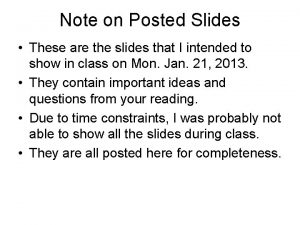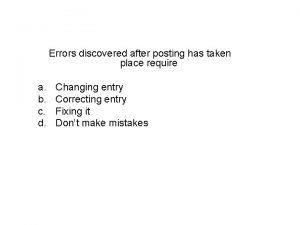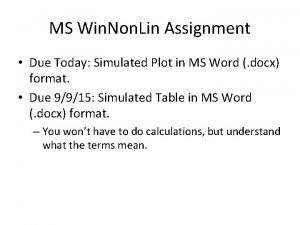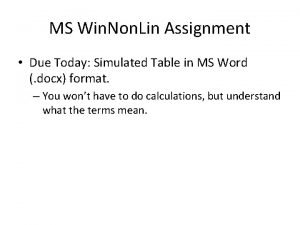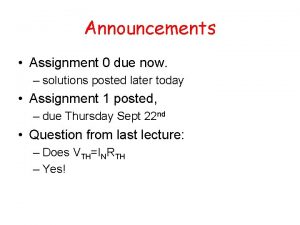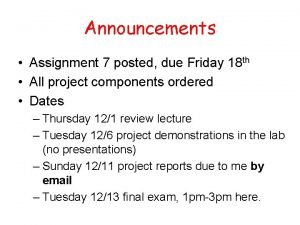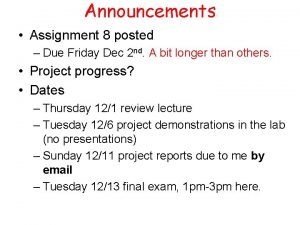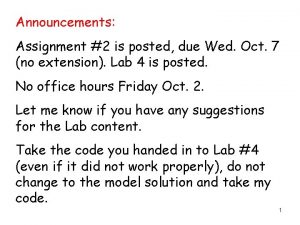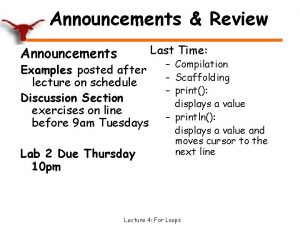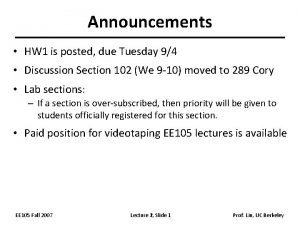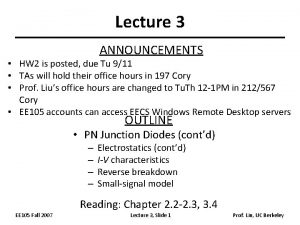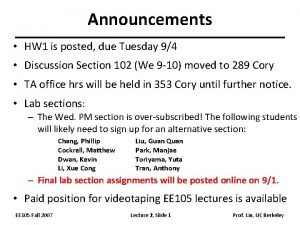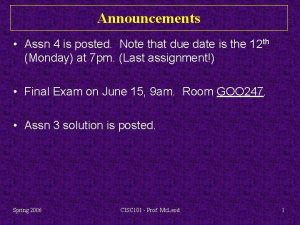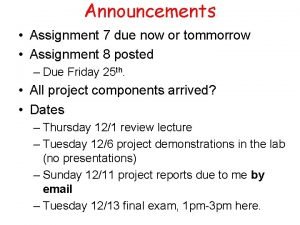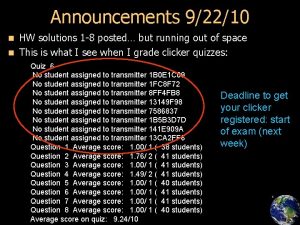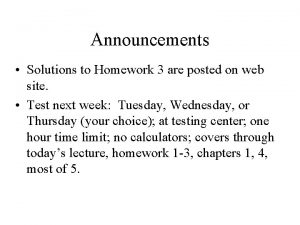Announcements Assignment 0 solutions posted Assignment 1 due


















- Slides: 18

Announcements • Assignment 0 solutions posted • Assignment 1 due on Thursday • DC circuit Lab reports due to Sajan today and tomorrow • This week’s lab – AC circuits

Lecture 6 Overview • AC Circuit Analysis • Filters

The Story so far… Generalized Ohm's Law: VS(jω)=ZIS(jω) • Voltage and current not in phase: • Current leads voltage by 90 degrees • Impedance of Capacitor decreases with increasing frequency • Voltage and current not in phase: • Current lags voltage by 90 degrees • Impedance of Inductor increases with increasing frequency • Voltage and current in phase • no frequency dependece

Inductors in AC circuits Inductive Load (back emf ) from KVL • Voltage and current not in phase: • Current lags voltage by 90 degrees • Impedance of Inductor increases with increasing frequency http: //arapaho. nsuok. edu/%7 Ebradfiel/p 1215/fendt/phe/accircuit. htm


AC circuit analysis • Effective impedance: example • Procedure to solve a problem – – Identify the sinusoid and note the excitation frequency Convert the source(s) to complex/phasor form Represent each circuit element by it's AC impedance Solve the resulting phasor circuit using standard circuit solving tools (KVL, KCL, Mesh etc. ) – Convert the complex/phasor form answer to its time domain equivalent

Example


Top: Bottom:

Transfer Function Hv(jω)= Transfer function Since we are interested in frequency response, use phasors. VL(jω) is a phase-shifted and amplitude -scaled version of VS(jω) Hv(jω) describes what the phase shift and amplitude scaling are.

Low pass filters • RC low-pass filter: preserves lower frequencies, attenuates frequencies above the cutoff frequency ω0=1/RC.

Low pass filters Break frequency ω=ω0=1/RC, HV=1/√ 2 N. B. decibels: For voltage For power

Build other filters by combining impedance response

Which of the following is a low-pass filter? What happens to the output voltage when ω→ 0 (DC condition)? Answer: (c)

Which of the following are high-pass or low-pass filters? Answers: (b) and (c) are highpass; (a) and (d) are low-pass

RLC Band-pass filters Measuring voltage output signal over R, Vr Low frequencies, C open, L shorted, Vr minimum High frequency, C shorted, L open, Vr minimum so, at high and low frequencies, see an open circuit - Vr minimum C L

Band-stop (Notch) filters Measuring voltage output signal over L and C Low frequencies, C open, L shorted, Vlc maximum High frequency, C shorted, L open, Vlcmaximum so, at high and low frequencies, see an open circuit - Vlc maximum

Another Example: Measuring voltage output signal over L and C, but this time in parallel (i. e. at high and low frequencies, see a short - V 0=0)
 Pvu announcement today
Pvu announcement today Kayl announcements
Kayl announcements R/announcements!
R/announcements! General announcements
General announcements David ritthaler
David ritthaler What happened when montag crossed the ten-lane highway?
What happened when montag crossed the ten-lane highway? Procedural due process vs substantive due process
Procedural due process vs substantive due process Pentacosiomedimni cavalieri zeugiti teti
Pentacosiomedimni cavalieri zeugiti teti Due piccole sfere identiche sono sospese
Due piccole sfere identiche sono sospese Quadrilatero con due angoli retti
Quadrilatero con due angoli retti Post the journal’s special amount column totals.
Post the journal’s special amount column totals. When installing tabletop equipment on legs
When installing tabletop equipment on legs Look mom europe
Look mom europe Examples of momentum
Examples of momentum After posting is completed there may be an error if
After posting is completed there may be an error if A food handler is reheating commercially processed cheese
A food handler is reheating commercially processed cheese Posted voucher rack
Posted voucher rack Assignment due today
Assignment due today Venule
Venule













